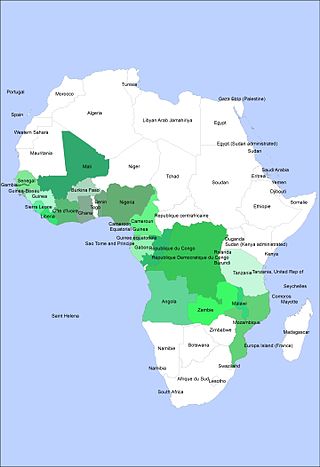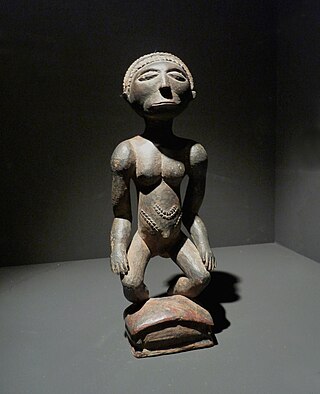

Lukasa, "the long hand" (or claw), is a memory device that was created, manipulated and protected by the Bambudye, a once powerful secret society of the Luba. Lukasa are examples of Luba art.


Lukasa, "the long hand" (or claw), is a memory device that was created, manipulated and protected by the Bambudye, a once powerful secret society of the Luba. Lukasa are examples of Luba art.
The story of the lukasa is closely associated with the history of the Luba kingdom, which dominated most of northern Shaba during the eighteenth century and the first half of the nineteenth century. No candidate for political office could receive his title without first becoming a member of the Bambudye society, and the ruler of the Luba kingdom held the highest ranking Bambudye title. Reefe states that while it is not possible to date the origins of the lukasa, the high degree of integration of the lukasa into the structure of the Bambudye society and into the oral lore of the Luba kingdom strongly suggests that this art form is of considerable antiquity.
Central to Luba artistry, lukasa aids memory and the making of histories. Stools, staffs, figures, and complex choreographies complement the lukasa as Luba culture is remembered, produced, and transformed.
Lukasa memory boards are hourglass-shaped wooden tablets that are covered with multicolored beads, shells and bits of metal, or are incised or embossed with carved symbols. [1] The colors and configurations of beads or ideograms serve to stimulate the recollection of important people, places, things, relationships and events as court historians narrate the origins of Luba authority. A lukasa serves as an archive for the topographical and chronological mapping of political histories and other data sets. [2]
Lukasa are approximately the same size (20-25 centimeters long and about 13 centimeters wide) and have the same rectangular dish shape. A row of carved mounds called lukala runs across their concave surface, dividing it in half. Beads and shells are attached to the board by small slivers of wood or hand-made iron wedges driven through their centers, and cowrie shells are frequently attached at the top and bottom. Beads are arranged in three ways: a large bead surrounded by smaller beads, a line of beads, and one isolated bead. Each configuration lends itself to the transmission of certain kinds of information. Board surfaces also have holes and lines cut into them. [1]
Court historians known as bana balute ("men of memory") run their fingertips across the surface of a lukasa or point to its features while reciting genealogies, king lists, maps of protocol, migration stories, and the great Luba Epic, a preeminent oral narrative that records how the culture heroes, Mbidi Kiluwe and his son Kalala Ilunga, introduced royal political practices and etiquette. [2] For Luba, how an object looks dictates how well it works. [3]
Culture heroes are identifiable by beads whose colors have a fan of connotations triggering remembrance of their deeds and exploits, as well as their qualities and physical appearance. For example, Nkongolo Mwamba, the tyrannical anti-hero of the Luba charter, is always represented by a red bead, for he is the red-skinned rainbow-serpent associated with bloody violence. Blue beads (considered "black") stand for Mbidi Kiluwe, the protagonist and culture-bearer of kingship whose skin is shiningly black like that of a bull buffalo, symbol of ambivalent power and secret potential. [4] The paths of Luba migration and significant events and relationships are indicated by lines and clusters of beads. Chiefs and their counselors, sacred enclosures, and defined places are shown by circles of beads. [5]
Mbudye is a council of men and women charged with sustaining and interpreting the political and historical principles of the Luba state. As authorities on the tenets of Luba society, Mbudye provide a counterbalance to the power of kings and chiefs, checking or reinforcing it as necessary. Members of Mbudye proceed through a series of stages within the society as they master successive levels of arcane knowledge. Only those at the apex of the association can decipher and interpret the lukasa's intricate designs and motifs. Mbudye members call the twin projections sprouting along the board's outer edge the "head" and "tail" of the lukasa, zoomorphic elements that are meant to evoke the crocodile. An animal equally at home on land and in water, the crocodile's dual nature is suggestive of Luba political organization, whose existence relies on the interdependence of the kikungulu (the head of the Mbudye) and the kaloba (the "owner of the land", or chief). [6]
The lukasa fulfilled many mnemonic functions, for it could be interpreted in a number of ways, and while all memory boards shared certain common information, particular types of memory boards communicated specialized data. There were three distinct categories of lukasa, each emphasizing a certain kind of knowledge. First, the lukasa Iwa nkunda, "the long hand of the pigeon", bears information on mythical heroes and early rulers and on the mythical migration routes of the Luba. Second, the lukasa Iwa kabemba, "the long hand of the hawk", is concerned with the organization of the Mbudye society. A third type of memory board was created for the use of individual Luba rulers and contained secret information about divine chiefship. No examples of this type, referred to as the lukasa Iwa kitenta, "the long hand of the sacred pool", still exist. [1]

A bead is a small, decorative object that is formed in a variety of shapes and sizes of a material such as stone, bone, shell, glass, plastic, wood, or pearl and with a small hole for threading or stringing. Beads range in size from under 1 millimetre (0.039 in) to over 1 centimetre (0.39 in) in diameter.
The history of Zambia experienced many stages from colonization to independence from Britain on October 24, 1964. Northern Rhodesia became a British sphere of influence in the present-day region of Zambia in 1888, and was officially proclaimed a British protectorate in 1924. After many years of suggested mergers, Southern Rhodesia, Northern Rhodesia, and Nyasaland were merged into the British Federation of Rhodesia and Nyasaland.

African art describes the modern and historical paintings, sculptures, installations, and other visual culture from native or indigenous Africans and the African continent. The definition may also include the art of the African diasporas, such as: African-American, Caribbean or art in South American societies inspired by African traditions. Despite this diversity, there are unifying artistic themes present when considering the totality of the visual culture from the continent of Africa.

Wampum is a traditional shell bead of the Eastern Woodlands tribes of Native Americans. It includes white shell beads hand-fashioned from the North Atlantic channeled whelk shell and white and purple beads made from the quahog or Western North Atlantic hard-shelled clam.
The pre-colonial history of the modern-day Democratic Republic of the Congo encompasses the history of the Congo Basin region up to the establishment of European colonial rule in the era of New Imperialism and particularly the creation of the Congo Free State and its expansion into the interior after 1885. As the modern territorial boundaries of the Democratic Republic of the Congo did not exist in this period, it is inseparable from the wider pre-colonial histories of Central Africa, the Great Lakes and Rift Valley as well as the Atlantic World and Swahili coast.

The culture of the Democratic Republic of the Congo is extremely varied, reflecting the great diversity and different customs which exist in the country. Congolese culture combines the influence of tradition to the region, but also combines influences from abroad which arrived during the era of colonization and continue to have a strong influence, without destroying the individuality of many tribal customs.

The Luba people or Baluba are an ethno-linguistic group indigenous to the south-central region of the Democratic Republic of the Congo. The majority of them live in this country, residing mainly in Katanga, Kasaï, Kasaï-Oriental, Kasaï-Central, Lomami and Maniema. The Baluba consist of many sub-groups or clans.

Kazembe is a traditional kingdom in modern-day Zambia, and southeastern Congo. For more than 250 years, Kazembe has been an influential kingdom of the Kiluba-Chibemba, speaking the language of the Eastern Luba-Lunda people of south-central Africa. Its position on trade routes in a well-watered, relatively fertile and well-populated area of forestry, fishery and agricultural resources drew expeditions by traders and explorers who called it variously Kasembe, Cazembe and Casembe.

The Kuba Kingdom, also known as the Kingdom of the Bakuba or Bushongo, is a traditional kingdom in Central Africa. The Kuba Kingdom flourished between the 17th and 19th centuries in the region bordered by the Sankuru, Lulua, and Kasai rivers in the heart of the modern-day Democratic Republic of the Congo.

The Nation of Lunda was a confederation of states in what is now the Democratic Republic of Congo, north-eastern Angola, and north-western Zambia. Its central state was in Katanga.

Traditional African masks play an important role in ceremonies, rituals, and masquerades across West, Central, and Southern Africa. Ceremonies in which masks are worn include harvest celebrations, funerals, rites of passage, weddings, and coronations. In some societies, masks and masquerades are also used to settle disputes and communal conflicts.

The Yoruba of West Africa are responsible for a distinct artistic tradition in Africa, a tradition that remains vital and influential today.
This is a history of Katanga Province and the former independent State of Katanga, as well as the history of the region prior to colonization.
The Songye people, sometimes written Songe, are a Bantu ethnic group from the central Democratic Republic of the Congo. They speak the Songe language. They inhabit a vast territory between the Sankuru/Lulibash river in the west and the Lualaba River in the east. Many Songye villages can be found in present-day East Kasai province, parts of Katanga and Kivu Province. The people of Songye are divided into thirty-four conglomerate societies; each society is led by a single chief with a Judiciary Council of elders and nobles (bilolo). Smaller kingdoms east of the Lomami River refer to themselves as Songye, other kingdoms in the west, refer to themselves as Kalebwe, Eki, Ilande, Bala, Chofwe, Sanga and Tempa. As a society, the people of Songye are mainly known as a farming community; they do, however, take part in hunting and trading with other neighboring communities.

Shell gorgets are a Native American art form of polished, carved shell pendants worn around the neck. The gorgets are frequently engraved, and are sometimes highlighted with pigments, or fenestrated.

The Kingdom of Luba or Luba Empire (1585–1889) was a pre-colonial Central African state that arose in the marshy grasslands of the Upemba Depression in what is now southern Democratic Republic of Congo.

The Holoholo also known as Kalanga are a Bantu ethnic group that inhabit the shores of central lake Tanganyika. The majority of them live near Kalemie city on Lake Tanganyika in Tanganyika Province of the Democratic Republic of the Congo, and on the opposite shore of the lake in Uvinza District of Kigoma Region in Tanzania.
The Hemba people are a Bantu ethnic group in the Democratic Republic of the Congo (DRC).
Lusinga Iwa Ng'ombe was a slave trader in the region to the west of Lake Tanganyika in the 1870s and early 1880s.

Luba art refers to the visual and material culture of the Luba people. Most objects were created by people living along the Lualaba River and around the lakes of the Upemba Depression, or among related peoples to the east in what is now the Democratic Republic of the Congo.